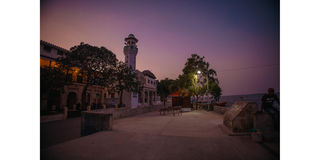Why this is the right time to explore Lamu

Lamu Stone Town sea front at dusk. Photo | Pool
What you need to know:
Watch out for the whale shark safari where you may have the opportunity to swim with the sharks
The tide is high in the late afternoon. The dark blue of the Indian Ocean reveals the lush green canopy of the mangroves fringing the island as we land on Manda Island and catch a boat across the channel to Lamu Island. This is the home of Lamu Stone Town which is the oldest Swahili settlement permanently lived on since the 14th century and listed as a World Heritage Site.
A short stroll from the pier, we’re at the door of the 16th-century Amu House that once belonged to a noble Swahili family as were the houses along the narrow lane.

Amu house. Photo | Pool
Fast forward to the 20th century. Mary Stone and her partner Hussein Ahmed met in the U.S. and arrived on the sunny isle in 1985. Both were builders in the US. They found the now run-down house, bought it and after two years of renovating it to its former glory, opened Amu House – the original name of Lamu – as the town’s first guest house in 1987.
Walking through the house with Stone, it’s interesting listening to how they carefully stripped layers of paint on the walls to reveal the vidakaor decorative etchings, the nyota (star) and the casa (turtle) and cleaned up the galleries that are the length of mangrove poles. The first gallery from the courtyard was for the men, and the inner ones were for the women.

Why this is the right time to explore Lamu. Photo | Pool
The following day, a short sail away from Stone Town, I’m at the Flipflopi boatyard to see the work of the year-old Heritage Boat Building Center where Flipflopi Ndogo the world’s first dhow made from 100% recycled plastic trash was constructed. Flipflopi Ndogo then sailed to Zanzibar and later circumvented Africa’s largest freshwater lake, Victoria, with one clear message: We’re dumping the earth and her waters with too much plastic waste. It’s time to stop.
It’s exciting meeting the students, many of whom are women dressed conservatively in the buibui, now learning the skills of boat and furniture building from recycled plastic waste collected from the beach.
The following day, it’s a leisurely stroll through the main commercial street where the famed wooden carved doors of the East African coast open to the centuries-old coral buildings with the ground floor turned into art galleries and fashion shops. The tourists are back in town after the Covid-19 hiatus.

Amu house Photo | Photosearch
A stop at The Fish gallery belonging to Isaiah Chepyator, the tall gentle Tugen now very much at home in Lamu, is full of his signature sculpted fish from recycled wood and plastic with his new collection of life-size crocodiles on display.
It’s midday and I hurry for lunch brushing past the donkeys laden with panniers of supplies to fill the shops or coral stones for construction. Passing by Mwana Kupona’s mansion, Lamu’s famed 19th-century poetess, I’m at Subira House behind the walls of the 19th-century Lamu Fort to lunch at the Karkadeh Restaurant – Swahili for red hibiscus that grows wild on Subira’s shamba. The flower is nutritious and helps reduce blood pressure. I’m here for a special meal of freshly prepared vegetable soup, grilled white snapper accompanied by many salads and sauces and finally a mouth-watering cashew-nut ice cream made with milk from the neighbours’ cow and cashew nuts from the farm.
Everything is cooked according to the principles of slow food cooking, a movement that’s been growing since the 1980s. “Slow food cooking is about being fair to the earth and people, eating food not treated or grown with chemicals and pesticides and finally, it must be tasty,” quips Kiki Aarts of Subira.
And then the highlight – a dhow sail at sunset to watch the red sun sink into the ocean, and the following day, a long stroll and swim on Shela beach before checking in for the flight to Nairobi.
Lamu Lore
Amu House is super-affordable and in the heart of Lamu Stone Town. It’s a bed & breakfast outlet. Indulge in the seafront restaurants like the Seafront Restaurant serving hearty seafood or try the street-food like mushkaki, kebabs and more.
Amu House started the Island Children Fund in the 1980s, putting hundreds of island children from disadvantaged backgrounds through primary school.
Safarilink flies daily to Lamu making a quick escape to the island possible
NOW ON: The whale shark season is on and now in Lamu waters. The largest fish on earth reaching more than 60 feet in length is a gentle slow-moving, filter-feeding carpet shark. Watch out for the whale shark safari where you may have the opportunity to swim with the shark. Rest assured, it doesn’t bite.
For dhow cruises or excursions, Amu House will arrange them.
Visit the Lamu Museum, Lamu House Museum and the German Museum – all easily walkable from Amu House.
www.rupitheafricantrotter.com




